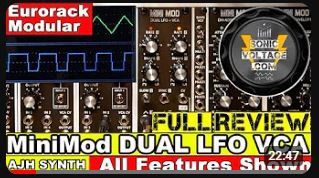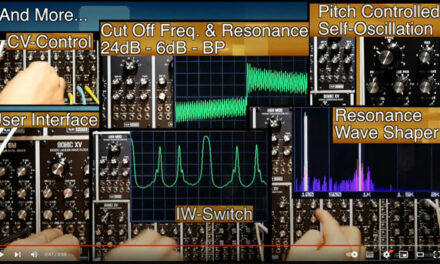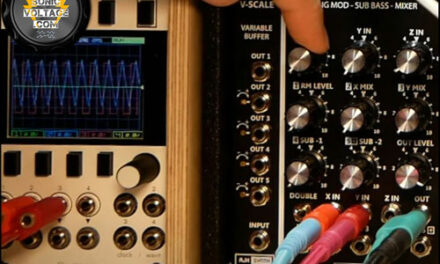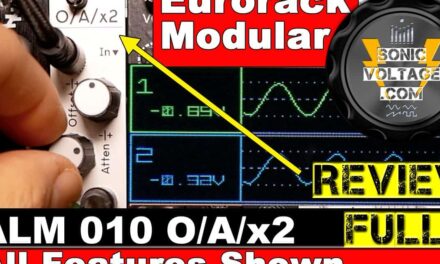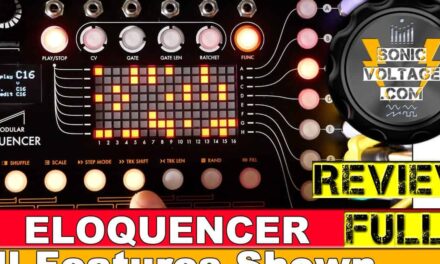AJH Synth Mini Mod Dual LFO + VCA Review. Eurorack Modular Format
Your Eurorack Modular Synthesizer can sound static without adding some VCA and LFO modules. The AJH Synth MiniMod Dual LFO + VCA will supply your eurorack synth with two independent LFOs and a unique setup VCA, all within 10HP of space in your eurorack cases.
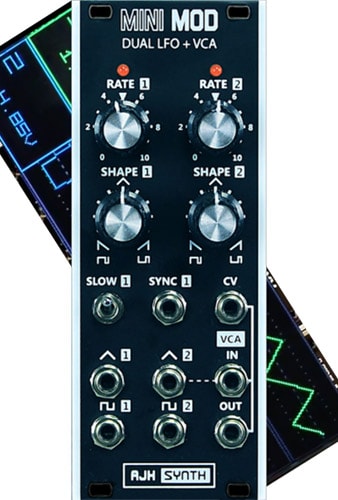
AJH Synth has built a great reputation within the world of modular synthesizers with their eurorack modules usually praised for build quality, audio signal path and overall sound quality. The module we are reviewing today is a utility module in eurorack format. The AJH Synth MiniMod Dual LFO + VCA offers two independent LFOs with variable rates and ‘continuously variable shape’ plus one DC Coupled VCA with linear response.
Let’s look at the LFOs for now. A nice set of features is present on both LFOs: Variable Rate, Variable Shapes, Two outputs per LFO. On top of that, LFO 1 sports a couple of extra features:
- LFO 1 can be set to a SLOW rate mode
- LFO 1 can receive a SYNC trigger
The SYNC resets the LFO’s Waveform to its starting point. You could use it to trigger the same LFO-Shape every time you trigger that specific sound (e.g. from a keypress). Sync Reset is a useful option to have on at least one of these two LFOs. The waveform can be restarted from a sync waveform with a fast leading edge or an envelope generator with a fast attack.
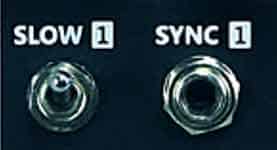
Each of the two LFOs offers a Rate Control Knob. AJH Synth modules are always well-built using quality components, the knobs on these modules are no exception, indeed they feel good under use.
The Rate Knob shows markings ‘0’ to ’10’ corresponding to a variable rate that goes from:
- 0.15Hz to 25Hz for Square and Triangle waves (or 6.5 seconds to 0.04 Seconds per cycle)
- 0.15Hz to 1Khz for Sawtooth, Pulse and Ramp (6.5 seconds to 1mS per cycle)
- LFO1 only, if set to SLOW mode, frequency range will vary from 0.01Hz to 2Hz (100 seconds to 0.5 seconds per cycle)
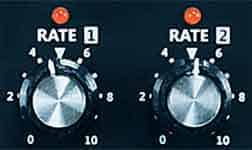
AJH Synth Dual LFO + VCA: LFO Variable Waveform Shape
A Shape Control Knob, one on each LFO, enables you to continuously modify the LFO Signal Shape present at the two outputs. Remember, these are two independent LFOs each with two separate outputs for a total of 4 LFO outputs. Each LFO has a Triangle Type output and a Square Type output. I use the word ‘Type’ because with the SHAPE KNOB, you can change the type of triangular or square LFO shape you get at the outputs.
- for the Triangle-Type signal you can vary, gradually, from a Sawtooth (shape-knob fully turned left) going into a Triangle (shape-knob 12 o’clock) then going into a Ramp (shape-knob turned fully right) – See images or video below.
- for the Square-Type signal you can vary the pulse-width part of the shape and go from a 98% Duty Cycle (shape-knob full left) to a perfect Square shape (12 o’clock) then into a 2% Duty Cycle (shape-knob full right) – See images or video below.
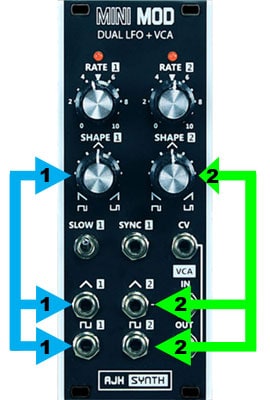
Fully anti-clockwise we start with a Sawtooth at the Triangle output and a 98% duty cycle at the Square output. Gradually turning the knob towards the middle position will change into…
… Triangle and Square wave with knob set at 12 o’clock.
Gradually turning the knob right past the middle position we change the shapes into…
… Ramp and 2% Duty Cycle Square Pulsse with the knob set fully clockwise.



Depending on the type of patch and the type of patch element you are controlling/altering with these LFOs, you could easily have hands-on control over ‘smooth to drastic’ variations of the character of your sound or even over rhythmic elements of your patch.
So far the set of features looks very promising (we didn’t even get to the VCA part yet). I say this because the ‘first impression’ is that we have, in only 10 HPs, four good size and easy-to-use Control Knobs, 4 outputs outputting variable LFO shapes, one switch to set one LFO to a slower rate plus the option to use one of the two LFOs in Sync mode.
I always pay attention to the user interface layout, size, ease of use and feel quality because, for me, one big attraction of using a hardware synth, especially eurorack modular synths, is the ‘touch and feel’ hands-on control you have over your patches. Overall rack space is always limited therefore a front panel that does not waste space while empowering the user with decent size, easy-to-use knobs, is always welcome in my book. Tiny, fiddly and hypersensitive knobs could easily ruin the experience and we have none of that here! Nice one AJH Synth.
What about the VCA? How has it been set up for us on this module?
AJH SYNTH MiniMod Dual LFO + VCA: VCA Section
This VCA with linear response has three patch connection points plus a normalised internal connection which sends the Triangle-type output of LFO 2 (+/- 5V) into the Input (IN) of the VCA. This normalised connection is pretty useful as it allows us to make use of VCA’d voltage without the need to source an input signal; we can then use the VCA output to control other parameters anywhere within our patch.
CV Input: to control the opening and closing of the VCA (0V to 5V, allows 0% to 100% of the input signal) – Effective CV Input range is 0-5V but up to +12V is safe to use.
IN: to send a signal through this VCA (plugging a signal into this input will disconnect the normalised connection to the LFO 2 Triangle Output)
OUT: the output of the VCA
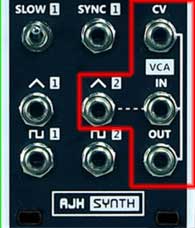
This is a helpful setup for us. With nothing plugged into the VCA-Input, you can use a CV Control Voltage (e.g. coming from an hardware controller, or modulation wheel…) to attenuate the LFO 2 Triangle Waveform present at the output of the VCA (VCA-OUT). This makes it easy to create a situation where you control the amount of LFO 2 Waveform modulation signal (coming out of the VCA OUT) via a Modulation Knob.
AJH Synth MiniMod Dual LFO + VCA: Conclusion And Final Thoughts
This Eurorack LFO Module from AJH Synth is a great addition to the AJH MINI MOD system and range of modules based on the early Moog Model D Analogue Synth. With the Model D synth, which didn’t have a dedicated LFO at all, you had to sacrifice a VCO (at slow rate) and use that VCO as an LFO, arguably a waste of VCO resources.
There is no CV control over Rate or Shape but you do have a CV input in the VCA section as mentioned above. If you were building a MINI MOD system, compared to Model D’s feature set, this Dual LFO + VCA module will spoil you with two flexible LFOs and a VCA. If you are enjoying the overall quality and clever layout of the user interface, consistent among all AJH Synth eurorack modules, then you simply have to have this module!
Beyond the realm of a MINI MOD system/Model D scenario and simply as a Eurorack Modular LFO and VCA module, this AJH Synth Module is still a great addition to any eurorack modular system.
10HPs with good size interface elements, additional versatility with variable LFO waveform shapes, sync, and variable rates… and you could employ the square output in pulse mode and use it as a sync source for the rest of your modular patch.
I want one!
If you find this post useful I would appreciate it if you could SHARE it (Forums, Facebook, Twitter, Instagram, etc…). It would help me a lot. And sharing will also tell me these reviews are being of some use to the readers which in turn pushes me to produce more reviews. Feel free to comment, ask questions below or leave comments under the video review and Subscribe to SonicVoltage YouTube Channel, I’ll do my best to reply.
Ok, people! Thank you for stopping by and/or watching the video review.
Until next time… Happy Euroracking, Have Fun!



